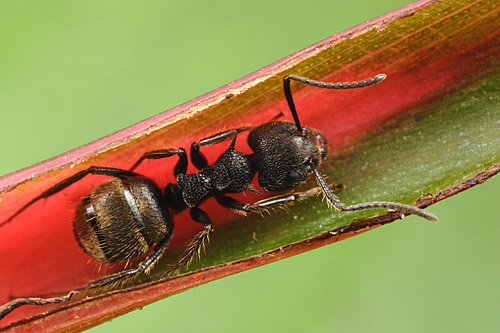
Leptomyrmex darlingtoni, Australia
A big day for ant evolution! The Ant Tree of Life research group (AToL) has published their dolichoderine phylogeny in the journal Systematic Biology.
Dolichoderines are one of the big ant subfamilies, comprising just under ten percent of the world's ant species. These are dominant, conspicuous ants noted for having ditched the heavy ancestral ant sting and armor in favor of speed, agility, and refined chemical weaponry. Most dolichoderines live in large colonies with extensive trail networks, and they fuel their frenetic lifestyle through copious consumption of hemipteran honeydew.
The paper is unfortunately behind a subscription barrier, but I've reproduced the primary finding below.

A cladogram of dolichoderine ant genera based on 10 loci and 48 taxa, simplified from Ward et al 2010.
The study is typical Phil Ward: exceedingly thorough from the first field collection to the last detail of the final analysis. The team employed 10 nuclear loci (without any missing data!) amplified from 48 specimens, using multiple species for the larger genera. The analyses took years to finish, not because the data set was large but because they meticulously tested numerous models, data partitions, and outgroups to probe the robustness of their trees.

Dolichoderus bispinosus, Panama
A few thoughts:
- Kudos to Steve Shattuck. Big kudos. The guy performed an exhaustive taxonomic reworking of the genera in the early nineties for his dissertation, based on morphology. And we see here all of Steve's genus-level taxonomic decisions reflected in the molecules. As far as AToL could discern, the existing genera are monophyletic.
- Back in the day, Bill Brown speculated based on the ubiquity of fossil Dolichoderines that this was an older group slowly succumbing to myrmicine domination, surviving as relicts in isolated places like Australia. But the AToL team provides little support for Brown's thesis. The enormous diversity of an Australian clade (there must be about 100 species of Iridomyrmex alone!) is young, 25 million years old, and apparently radiating quite actively.
- The relationships deep in the tree hinge on a number of factors, most disturbing of which is the inclusion of Aneuretus as an outgroup. Aneuretus simoni is the single surviving representative of an ancient subfamily, it is found only on Sri Lanka, it is not common, and it may well become extinct within our lifetimes. Yet our ability to reconstruct its sister group's evolutionary past depends on access to rare Aneuretus DNA. Conservation of our biological resources is imperative for research, too.

Tapinoma sessile, USA
source: P. S. Ward, S. G. Brady, B. L. Fisher , and T. R. Schultz. 2010. Phylogeny and Biogeography of Dolichoderine Ants: Effects of Data Partitioning and Relict Taxa on Historical Inference. Systematic Zoology Advance Access published on March 31, 2010, DOI 10.1093/sysbio/syq012.
- Log in to post comments


Phooey. Hate it when I can't download or even read an interesting paper. But it sounds so exciting!
I would have expected Tapinoma and Technomyrmex to come out as sister genera given their nearly identical and peculiar "non-scaled" petiole, among other things. Oh well.
BTW, "Systematic Zoology Advance Access", that's very nostalgic on your part Alex ;)
Very nice, especially the congruence with Steve's morphological genera (although the tree doesn't seem to be fully resolved, so ...). I hope you are studying his key to Aussie ants while considering your book - illustrating every key character and having the illustrations next to the couplets made even ant genera accessible to acarologists.
About half the Australian Myrmozercon species (i.e. 2) are known from Iridomyrmex ants - clearly a highly evolved and discriminating genus.
Thanks, especially to Alex, for the very kind words. When I suggested looking at the dolichoderines for my thesis project people said I was crazy, and they were almost right - it took 18 months to crack the "Iridomyrmex problem" and split it into the 5 genera we have today. I was reassured it was OK when Bede Lowery, by far the best collector of Australian ants, said that what I was proposing made sense to him based on his field observations. And now to have an independent dataset confirm it is exciting (and a bit of a relief!).
For the Australian Ants book, I rewrote it three times before I was happy: the first was too technical, the second was too casual and the third finally got the balance about right. And I have Natalie Barnett to thank for the excellent "cartoon" drawings. I had the vision but she mastered an early version of Freehand (before the days of Illustrator) to create hundreds of drawings within a very short period of time. It would have been impossible with pen-and-ink, the standard in those days.
As Alex suggested, Brian Heterick and I are putting the finishing touches on a species-level revision of Iridomyrmex. It's proven exceptionally complex given that the group contains some 80 species and yet is so young (having split from its sister genus approx. 8mya). Several "species" show complex patterns of morphological variation and yet minimal genetic divergence (based on COI) while at least one other clade shows similar morphological variation but has deep branches based on this same gene. Clearly there's a huge amount of evolution going on here and our paper certainly won't be the last word on these fascinating ants. Australia is the place to be if you're interested in ants.